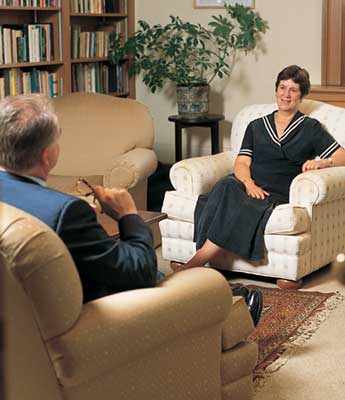|
Nancy
Dye's Presidency, Page 3

Budget
and Buildings
While the College community worked on healing itself, Dye prepared
to tackle another problem: a $3.2 million deficit. In pinpointing
ways to balance the 1996 budget while reducing annual tuition increases,
she and her senior staff again chose the democratic route: cutback
by consensus. The College saved $5 million, much of which was directed
at strategic goals of improving faculty salaries, which had slipped
over the years in terms of being competitive with other peer colleges,
and making scholarship assistance to students more generous, an
issue Dye had identified as critical to strengthening admissions
in the College and Conservatory.
At the same time, it had become clear that Oberlin was in dire need
of new facilities, particularly in the sciences. The College continued
its tradition of propelling more future PhDs into the sciences than
any other undergraduate institution, yet the nearly 30-year old
Kettering Hall had neither the space nor equipment to ensure the
school’s ongoing competitiveness. Intensive planning for a
new building began in 1996, with the board approving $65 million
for the 200,000-square-foot complex a year later.
“Science is dependent upon the quality of its plant and instrumentation,”
Dye says. “And the Science Center is designed to provide space
and facilities for every science major to work on independent research
projects with faculty members.” Already, chemistry, neuroscience,
and some biology classrooms and labs are in use, as is the science
library, lecture halls, and a commons area. Meanwhile, environmental
studies, the College’s fastest-growing major, settled comfortably
into its new home, which attracted 5,000 visitors from around the
world last year. Striving continuously for energy efficiency both
in and outside the building, Dye hired a team of engineers last
year to audit all emissions produced by the College.
“If you had to encapsulate the one thing that has happened
with Nancy, it is momentum, a sense of possibility,” says Clayton
Koppes, dean of the College of Arts and Sciences. “Things are
happening at Oberlin that we weren’t sure we could do. New
resources are available, and there is a sense of reaching out in
all kinds of ways in contrast to previous periods in Oberlin’s
history.”
Dye has garnered praise in the past few months for her proposal
to reinstate a teachers’ education program in the form of a
fifth year of intensive training and student-teaching experience.
Hispanic studies was removed from the umbrella of Romance Languages
to become an independent and more viable department. And Finney
Chapel’s new Kay Africa Memorial Organ/Fisk Opus 116 made its
concert debut in September following a year-long tuning process.
“One of the things that sets Oberlin apart from its competitors
is its dual nature: an elite liberal arts school and a professional
school of music,” says Dean of the Conservatory Robert Dodson,
who was hired by Dye in 1999. “There are many instances where
the two interests run at 90 degree angles to each other. Part of
the genius of this place is that one complements the other in this
fascinating dyadic relationship.”
Ellen Sayles, associate dean of the Conservatory and a member of
the search committee that chose Dye, says that while the president
understands the differing climates and needs within the College
and Con, she has also worked hard to support them as a single Oberlin
unit. “Nancy has been committed to helping the Conservatory
draw and retain internationally known faculty, and she has supported
the Conservatory’s need to maintain a competitive scholarship
program in order to continue to attract the most outstanding student
musicians.” At the same time, says Sayles, Dye recognizes the
fact that many Arts and Sciences majors have a deep interest in
music, and she endorses programs and activities that provide a rich
musical environment for all students.
Go
to page 1 | 2
| 3 | 4
| 5 of Nancy Dye's Presidency
|




